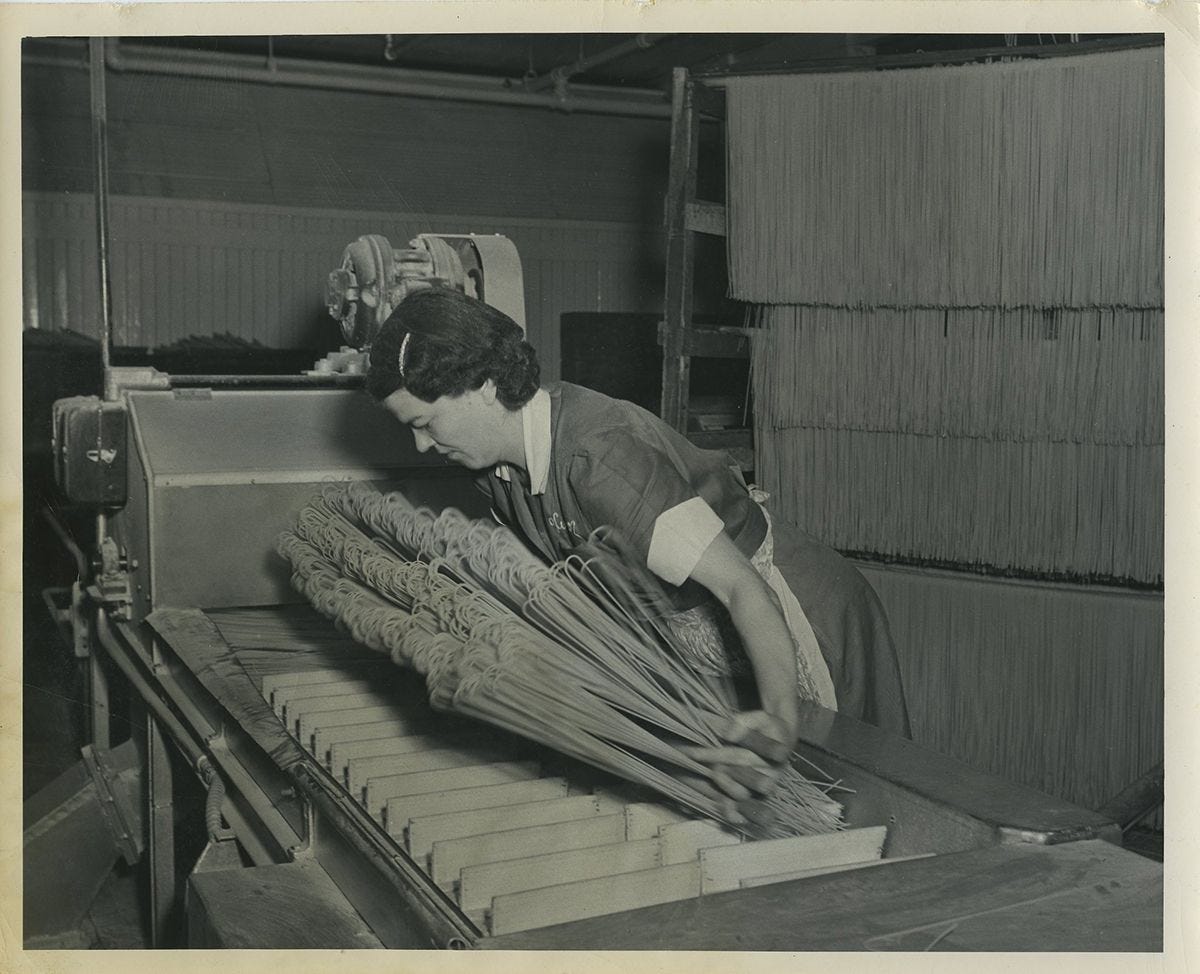
A woman is making spaghetti at the VIMCO macaroni factory in Carnegie, PA, owned by Salvatore Viviano of Viviano Macaroni Manufacturing Co. {Image Attribution}.
Women, mysteries, and magicians surrounding the myth of macaroni.
Buongiorno amici
The legend of macaroni, among “nciucesse,” women and magicians, is one of Southern Italy’s greatest mysteries. A nciucesse is a lady who calumniates others. Do you know any?
The earliest evidence of an actual macaroni occurred at the juncture of medieval Sicilian, Italian, and Arab cultures. Initially attributed to Etruscans, Greeks, Romans, and Chinese, the true history of macaroni in Italy and Sicily is lost in early times and not fully verifiable, or at least with plausible accuracy.
In the United States, we credit Thomas Jefferson with bringing the first pasta machine into the land, which he purchased in France of all the strangest places. (Let’s face it, the French will never publicly admit to liking pasta but will consume it in hiding). Years later, Jefferson’s credited his wife for making the first example of macaroni and Parmesan, something he learned while in Europe. Not too keen on the taste of Parmesan, the statesman replaced it with Vermont cheddar, which may have originated the Mac & Cheese classic we crave so much.
But let’s go into the story.
Years ago, in the Kingdom of Naples, a wizard lived on the top floor of a narrow, long, and extended house. He spent the days alone, always bent over reading books, and fumbling with a hot pot on the fire, often kneading some white powder. The wizard rarely went out, and when he did, it was only to buy supplies of fresh herbs and local vegetables. He always dressed in black, with a long white beard, feared by everyone, and surrounded by weird personal stories about him.
One day a nciucessa neighbor saw the magician leaving the house walking toward a store for the daily shopping and entered the residence from the nearby terrace, eager to understand what the extravagant man was all about. As soon as she entered, the woman noticed a messy table with a mysterious white powder scattered on top of an open book. She saw that some pages contained writings in beautiful calligraphy, while others were still blank. She quickly flipped through the book, slipped it into her apron pocket, leaving the wizard’s house rapidly. Back at home, the joyful woman showed the book to her husband, peacefully seated near a fireplace. While reading the book with amazement, they learned that the mysterious finely ground white powder was nothing more than wheat and, once mixed with the proper doses of water, gave birth to a new food, a strange but tasty food: macaroni! The magical combination of water and flour was born and quickly spread throughout the kingdom of Naples and beyond.
{A family eating maccheroni with hands before the advent of the fork. Image Attribution via Locale Mio}
What’s in a name?
The name’s origin is truly a mystery, perhaps deriving from the word “Maccarone,” typical Southern Italian slang referring to someone occasionally distracted. Some historians believe that the appellation derives from “macco,” the Sicilian dish of crushed ancient legume—a similar process used to grind wheat into flour. Perhaps the etymology of the word macaroni has two variants: a connection to the Byzantine Greek “makarònia,” a funeral song, celebrating a funeral meal, or maybe deriving from the Greek word “macharia” barley soup. In any event, regardless of when and where macaroni originated, we still love the taste, with any sauce combinations or simply with olive oil, Parmigiano, and a dash of black pepper. Thomas Jefferson might have been a skilled diplomat, a proficient architect, and a philosopher. Still, I have severe doubts about his cooking skills, or at least on the cheddar over macaroni deal.
Thanks for reading. Eat safe! Ciao Chef W
Download Chef Walters E-Books
Please tune in to our latest Flavors + Knowledge Podcast
Subscribe to the Italian version SAPERE + SAPORI
Subscribe to News you can eat 24 Video-Cast on YouTube
Support Chef Walters Children’s Diabetes Foundation
For recipes, visit the chef blog.
| 4 |

